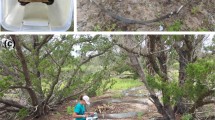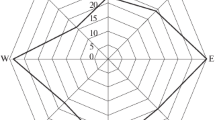Summary
The nest-site preferences of six burrowing petrel species, Salvin's prion Pachyptila vittata salvini, blue petrel Halobaena caerulea, great-winged petrel Pterodroma macroptera, Kerguelen petrel Pterodroma brevirostris, soft-plumaged petrel Pterodroma mollis and white-chinned petrel Procellaria aequinoctialis, in the northeastern part of Marion Island (Prince Edward Island group, southern Indian Ocean) were analyzed by step-wise multiple regression. The nest-site characteristics measured were slope angle, soil depth and moisture content, percentage cover by stones or boulders and percentage cover by each of seven major plant species. The major nest-site preferences were: exposed areas with shallow soil (Salvin's prion); steep coastal slopes (blue petrel); sheltered well-drained slopes with deep soil (great-winged petrels); wet areas along drainage lines (Kerguelen petrel); steep slopes (soft-plumaged petrel); and areas with deep soil (white-chinned petrel). Similar species showed no significant avoidance of nest sites where there were burrows of potential competitors but did tend to nest spread out over different habitats. Burrow densities were determined in six habitat and seven vegetation types. Salvin's prion was the most abundant species (81% of burrows, with a maximum density of 279 burrows ha-1) and used both burrows and natural cavities for nesting. For all species combined, burrow densities at Marion Island were lower than in comparable habitats and vegetation types at neighbouring Prince Edward Island. Depredation by feral house cats Felis catus, absent from Prince Edward Island, is assumed to be largely responsible for this difference.
Similar content being viewed by others
References
Aarde RJ van (1979) Distribution and density of the feral house cat Felis catus at Marion Island. S Afr J Antarct Res 9:14–19
Aarde RJ van (1980) The diet and feeding behaviour of feral cats, Felis catus, at Marion Island. S Afr J Wildl Res 10:123–128
Adams NJ (1982) Subantarctic Skua prey remains as an aid for rapidly assessing the status of burrowing petrels at Prince Edward Island. Cormorant 10:97–102
Berruti A (1981) The status of the Royal Penguin and Fairy Prion at Marion Island, with notes on feral cat predation on nestlings of large birds. Cormonant 9:123–128
Berruti A, Griffiths AM, Imber MJ, Schramm M, Sinclair JC (1981) Status of seabirds at Prince Edward Island. S Afr J Antarct Res 10:32–33
Brothers NP (1984) Breeding, distribution and status of burrow-nesting petrels at Macquarie Island. Aust Wildl Res 11:113–131
Crawford AB (1952) The birds of Marion Island, south Indian Ocean. Emu 52:73–85
Croxall JP, Hunter I (1982) The distribution and abundance of burrowing seabirds (Procellariiformes) at Bird Island, South Georgia. 2. South Georgia Diving Petrel Pelecanoides georgicus. Br Antarct Surv Bull 56:69–74
Croxall JP, Prince PA (1980) Food, feeding ecology and ecological segregation of seabirds at South Georgia. Biol J Linn Soc 14:103–131
Derenne P, Mougin J-L (1976) Les Procellariiformes à nidification hypogée de l'île aux Cochons (archipel Crozet, 46°06′S, 50°14′ E). Com Natl Fr Rech Antarct 40:149–175
Gillham ME (1956) Ecology of the Pembrokeshire Islands. 5. Manuring by the colonial seabirds and mammals with a note on seed distribution by gulls. J Ecol 44:429–454
Gremmen NJM (1981) The vegetation of the sub-Antarctic islands Marion and Prince Edward. Geobotany 3:1–149
Hall K (1980) Late glacial ice cover and palaeotemperatures on Sub-Antarctic Marion Island. Palaeogeogr Palaeoclimatol Palaeoecol 29:243–259
Harris MP, Bode KG (1981) Populations of Little Penguins, Shorttailed Shearwaters and other seabirds on Phillip Island, Victoria, 1978. Emu 81:20–28
Huntley BJ (1971) Vegetation. In: Zinderen Bakker Sr EM van, Winterbottom JM, Dyer RA (eds) Marion and Prince Edward Islands. Rep South Afr Biol Geol Exp 1965–1966. Balkema, Cape Town, pp 98–160
Payne MR, Prince PA (1979) Identification and breeding biology of diving petrels Pelecanoides georgicus and P. urinatrix exsul at South Georgia. NZ J Zool 6:299–318
Rand RW (1954) Notes on the birds of Marion Island. Ibis 122:476–488
Schramm M (1983) Predation by subantarctic skuas Catharacta antarctica on burrowing petrels at Marion Island. S Afr J Antarct Res 13:41–44
Schulze BR (1971) The climate of Marion Island. In: Zinderen Bakker Sr EM van, Winterbottom JM, Dyer RA (eds) Marion and Prince Edward Islands. Rep South Afr Biol Geol Exp 1965–1966. Balkema, Cape Town, pp 16–31
Sinclair JC (1980) Subantarctic Skua Catharacta antarctica predation techniques on land and at sea. Cormorant 8:3–6
Smith VR (1976a) Standing crop and nutrient status of Marion Island (sub-Antarctic) vegetation. J S Afr Bot 42:231–263
Smith VR (1976b) The effect of burrowing species of Procellariidae on the nutrient status of inland tussock grassland on Marion Island. J S Afr Bot 42:265–272
Smith VR (1979) Animal-plant-soil nutrient relationships on Marion Island (Subantarctic). Oecologia (Berlin) 32:239–253
Vermeer K, Vermeer RA, Summers KR, Billings RR (1979) Numbers and habitat selection of Cassin's Auklet breeding on Triangle Island, British Columbia. Auk 96:143–151
Verwoerd WJ (1971) Geology. In: Zinderen Bakker Sr EM van, Winterbottom JM, Dyer RA (eds) Marion and Prince Edward Islands. Rep South Afr Biol Geol Exp 1965–1966. Balkema, Cape Town, pp 40–62
Warham J (1977) Wing-loadings, wing shapes and flight capabilities of Procellariiformes. NZ J Zool 4:73–83
Warham J, Wilson GJ (1982) The size of the Sooty Shearwater population at the Snares Islands, New Zealand. Notornis 29:23–30
Zinderen Bakker Jr EM van (1971) Comparative avian ecology. In: Zinderen Bakker Sr EM van, Winterbottom JM,Dyer RA (eds) Marion and Prince Edward Islands. Rep South Afr Biol Geol Exp 1965–1966. Balkema, Cape Town, pp 161–172
Author information
Authors and Affiliations
Rights and permissions
About this article
Cite this article
Schramm, M. Burrow densities and nest site preferences of petrels (Procellariidae) at the Prince Edwards Islands. Polar Biol 6, 63–70 (1986). https://doi.org/10.1007/BF00258254
Received:
Accepted:
Issue Date:
DOI: https://doi.org/10.1007/BF00258254




